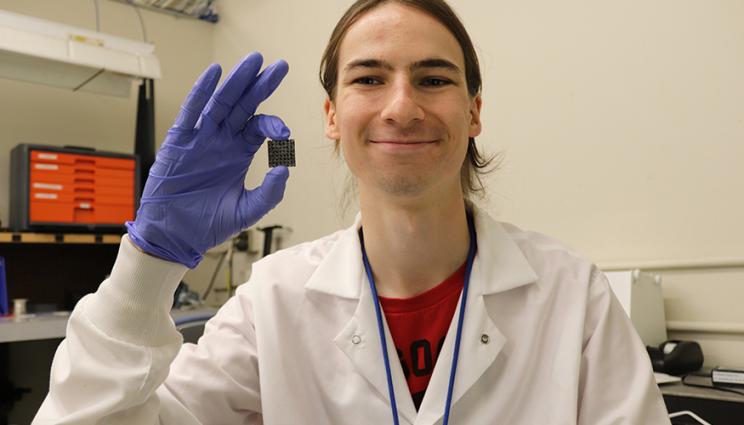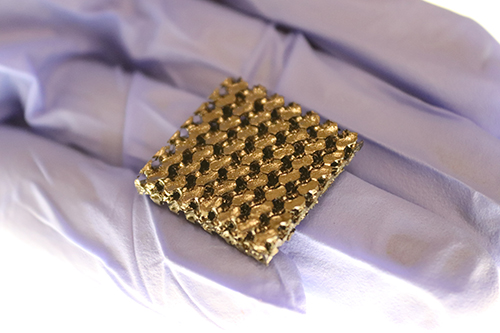
LLNL summer intern Oliver Philbrick holds a component he produced as part of a proof-of-concept project involving scale-up of 3D-printed carbon aerogels using customized feedstocks and a light-based 3D-printing technique. Aerogels are a unique class of low-density, high-surface-area, durable materials that present huge potential advances for scientific research and industrial applications.
A visit to Lawrence Livermore National Laboratory (LLNL) last summer by a university professor led to a unique internship opportunity for an undergraduate student this summer: helping LLNL scientists fabricate higher-performing carbon aerogel structures for electrodes and other energy-storage applications.
In 2021, Professor Anthony Santamaria from Western New England (WNE) University in Massachusetts visited LLNL during a brief sabbatical to learn more about how LLNL scientists use 3D-printing technology to fabricate aerogel materials. During his visit, hosted by LLNL chemical engineer Marcus Worsley, he was able to produce aerogel materials with a variety of architectures, which he brought back to WNE to test during the academic year.
Summer intern Oliver Philbrick, who is earning a mechanical engineering degree at WNE, was one of the students who helped with the performance testing at WNE. When Philbrick learned about the opportunity to come to LLNL as an intern for follow-on work, he was eager to apply, hoping to expand his experience from testing 3D-printed parts to fabricating new designs.
Fabricating carbon aerogel structures
During his 12-week internship at LLNL this summer through the LLNL's Materials and Chemistry Institute (MaCI) summer internship program, Philbrick is working on a proof-of-concept for scaled-up, 3D-printed carbon aerogels using customized feedstocks and a light-based 3D-printing technique known as stereolithography. The goal is to analyze whether it is possible to engineer microporous, electrically conductive lattice networks in the material, so it can be used for fuel cell applications where lightweight, highly tailored shapes are needed.

Philbrick is collaborating with his mentor, LLNL materials scientist Swetha Chandrasekaran, to test various production methods using research-scale 3D printers and determine if it's possible to fabricate a pseudocapacitive structure - a material that can chemically store an electric charge and offer a high energy-storage capacity. His work involves programming the 3D-printing technology, developing ink that serves as the feedstock, producing the structures and coordinating the post-production process.
The steps in this process may sound similar to how a baker creates a pie. Philbrick starts by creating a 3D polymer mold with the desired architecture, and then he adds the feedstock ink to the mold. Next, he infiltrates the polymer template by spinning the mold so that the ink fills all areas of the mold. Then, the ink is gelled and carbonized by heating it in a furnace at a high temperature. Finally, he tests various ways to detach the mold, such as dissolving it or burning it off chemically, to determine if the aerogel is damaged by the removal process.
Tangible and intangible rewards of an LLNL internship
According to Philbrick, the most interesting part of his internship is being able to produce something that nobody else has ever manufactured, using a process he helped to develop. "It's rewarding to see something tangible result from my work," he said. He also enjoys learning how to use sophisticated 3D-printing techniques - a huge benefit of being able to participate in an on-site research internship.
Philbrick meets with his LLNL mentor on a regular basis to identify what is working well and explore ways they can modify the process to overcome barriers, such as cracked molds or a lattice structure that doesn't offer adequate electrical conductivity. He's also learning what it's like to be part of a world-class research environment. Through this experience, he identified new options for his future career path: opportunities in materials science.
Philbrick's explorations at LLNL extend beyond his hands-on experience with 3D-printing technology and regular meetings with his mentor. He also has been able to attend on-site seminars for LLNL summer students, including his favorite seminar, which explored the theory behind fuel cells.
"Oliver has truly maximized his internship experience at our Laboratory," Chandrasekaran said, "providing valuable help to our research team by testing the feasibility of producing customized shapes for tomorrow's fuel cell applications. In addition, Oliver is coaching our research team regarding how to use a new type of software to generate 3D CAD models, which will help us achieve specific production goals."
"We were thrilled that the faculty mini-sabbatical led to so many unique learning experiences for Oliver, including his on-campus research and his internship with us this summer," said Worsley, who directs MaCI.
-Lisa Valdez






